England (Summer 2003)
Friday, July 26, somewhere in the air
Everyone said my husband Jack and I were crazy to take six teenagers to England.
Everyone may have been right.
The first flight, L.A. to Minneapolis, was fine. Three-and-a-half hours, and everyone was excited.
This second leg, however, Minneapolis to London, seems interminable. Seven hours so far, one-and-a-half to go. My three kids and their three friends have the loudest voices on the plane. They are stir-crazy and, consequently, silly. It is hot. Wedged between Jack and our 14-year-old son, Blake, I am slowly going nuts. Blake has not stopped moving since the moment he was born, and this trip is no exception. Wiggle, wiggle, wiggle. He and his friend Dan are writing a treatment for a new video game they're inventing, and Blake drops his pen. Ten minutes of intense wiggling until he manages to retrieve it. ACK!
A nice young man is coming down the aisle with breakfast, but I am not hungry. I just want off. I am reminded of the last stage of pregnancy, when all I wanted was to get the baby out of me, but there was nothing to do but wait.
Why is it that I always forget how miserable it is to fly this far confined to a three-foot-square area? Must buy a lottery ticket when I get home. Next time, I want to fly first class.
Saturday, July 27
Arrive about 9:00 am and call the car rental place to pick us up. Small
problem: we'd reserved an 8-seater automatic minivan, but all they have is
a 9-seater manual shift. Jack hasn't driven a stick shift car for fifteen
years or more, and I never have. I'm grateful to find he does very well
with it, even shifting with the opposite hand while driving on the
wrong
side of the road. And the van is huge—extra wide and
long in a country of narrow lanes and tiny cars. Well, we'll cope. We have
no choice. None of the other car rental places have vans that will seat
eight at all.
We cannot check in until 4:00 pm, so we've planned to visit Hever Castle in Kent today. The day is sunny, the drive a little tense but beautiful, so much greener than Southern California. Twisting roads lined with trees that meet overhead. We have to pull over whenever a car approaches from the other direction, which thankfully is not often.
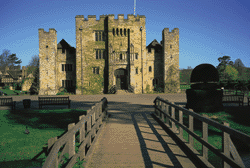 Hever Castle.
Hever Castle.
Hever Castle is lovely, built in the late 1200's, expanded in the 1500's, and beautifully restored by the Astor family in the early twentieth century. A real drawbridge over a moat, a double-portcullised gatehouse. We've never seen Hever Castle before, but my children have seen other castles, and they excitedly explain the defenses to their friends. We're not in Disneyland, someone says; this castle is real.
The rooms are gorgeous yet small enough to look livable, the castle chock full of 16th and 17th century furniture including King Henry VIII's tester bed with its counterpane of cream fur. Anne Boleyn grew up here, and bits of her are everywhere—an exquisite Book of Hours with her name inscribed in the front, her intricate needlework, her carved oak bed. The rooms smell a bit musty, the scent a combination of aged wood and ancient fabric, not enough to overwhelm, just enough to remind one of how very old these chambers and their furnishings really are. The kids are charmed, oohing and aahing over this and that—not three hours in England and already walking the paths of kings and queens, surrounded by the very things they touched and lived with.
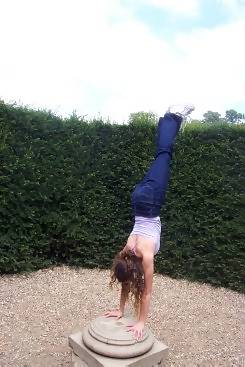 Devon does a victory handstand in the center (centre) of
Hever's maze.
Devon does a victory handstand in the center (centre) of
Hever's maze.
Back outside, we wander the yew maze, half of us going left while the other half go right. The left-handers find their way a good ten minutes before us righties, who seem to wander around forever, surely visiting every nook and cranny. In the tiny garden in the maze's center, my 13-year-old daughter Devon and her friend Anna, both gymnasts, do handstands to much applause. We snap pictures and then head out, all going right now and finding our way without one false move.
The gardens are beautiful, the flowers a brilliant range of colors and varieties. The rose garden boasts every hue you could imagine. We're tired, though, so we hurry through and then grab some drinks and hit the road. It's past lunchtime, but everyone's jetlagged and no one's really hungry.
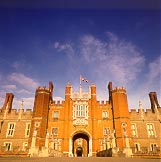 Hampton Court Palace's front entrance.
Hampton Court Palace's front entrance.
Finally, at about 4:00 pm, we arrive at Hampton Court Palace, one of Britain's top tourist attractions and our home for the next week. No description could truly capture the size and impressiveness of Hampton Court's many buildings. Perched alongside the River Thames, it is a little city unto itself. Through the imposing gatehouse sit three massive courtyards, mostly three stories high and all surrounded by rabbit warrens of smaller courtyards and corridors. The whole sits in the center of acre upon acre of magnificent gardens. We check in at the gates to receive our security passes (the palace is owned by the Queen, so we had to send in clearance forms weeks ago) and are directed to a courtyard where we park. Everyone is very excited to see our temporary home.
We've rented the Georgian House, one of two apartments available to the public through the non-profit Landmark Trust. A friendly warden ushers us through our own private garden—easily four times the size of the backyard at our suburban home—and opens the door to the house, then hands us the key.
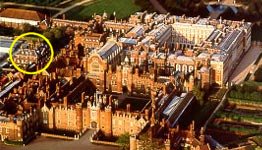 Hampton Court Palace, with the Georgian House circled in yellow. Our
garden is the dark area just above it.
Hampton Court Palace, with the Georgian House circled in yellow. Our
garden is the dark area just above it.
The Georgian House is in the newest part of Hampton Court, built in the
early 1700's. Our apartment occupies about one-third of the building.
Downstairs we have a stately dining room with burgundy walls and antique
furniture; a huge sitting room with fresh flowers, a fireplace, and
shelves of old books about Hampton Court and the surrounding area; a small
yellow study with a desk and several cushy leather chairs; an enormous,
fully-equpped kitchen; and a half bath. The next floor up boasts three
bedrooms and a full bathroom, and the top floor has two more bedrooms and
a third bath all housed beneath sloping eaves. Most of the windows look
out on our private garden or the courtyard where we drove in, called
Tennis Court because it leads to the old indoor tennis court where
Real
or Royal
tennis is still played.
 Fish Court.
Fish Court.
My family has stayed at Hampton Court once before, at an apartment in Fish Court, a long, very narrow courtyard just steps from here—across Tennis Court, through an old arched door, and down a short dark passageway. The Fish Court apartment is smaller and two centuries older, and frankly, we found it a bit spooky. We think we'll sleep easier here in the Georgian House.
The kids all choose bedrooms, then we pile back into the van and head out
to the supermarket to buy food for breakfast all week and dinner tonight.
As usual in Britain, we find ourselves tempted by all the different
goodies we don't see in the States. Everyone tosses their choices into the
shopping cart, called a trolley here, and we eventually walk out with way
too many groceries. Back home,
we put everything into our
refrigerator and freezer and then prepare a quick, eclectic meal. Lobster
croquettes, pizza, mushroom canelloni, chicken and asparagus pie, and
assorted fruit, all arranged on blue and white dishes on the long, dark
wood table. We are all so tired nobody thinks they are hungry, but we
polish off every morsel, then attack all the intriguing sweets we were
tempted to buy.
After everyone helps with the dishes, we all filter out to our garden to
enjoy the warm night—it's almost 8:00 but still bright. Devon and
Anna practice their gymnastics floor routines while Blake and Dan stage a
contest to see who can land more stones into the birdbath
in the
garden's center—an old, carved stone font. Our 16-year-old, Brent,
and his friend, Darci, sit in the vine-covered gazebo in the corner,
talking quietly. Jack and I sit on the grass and watch them all, happy the
long day is drawing to a close and all has gone relatively well.
Back in the house, we flip through the fat guest book provided by Landmark
Trust, where everyone who has stayed here has written an account of their
experiences. Going back to the first visitors in 1993, there are funny
stories and thoughtful ones. Recommendations of restaurants and tours.
Some guests have drawn pictures. One kid complained there was no TV, then
the next family claimed they found the secret TV under the stairs. Our
kids run to the little closet there to check, only to find a piece of
paper that says, This is the TV.
HA!
We're weary, but we can't resist exploring the grounds before bed. We walk through Base Court, Cardinal Wolsey's red-brick Tudor courtyard with its charming and varied chimneys; Clock Court with Henry VIII's magnificent 24-hour astronomical clock keeping time by the Great Hall; and Fountain Court, the stately Palladian courtyard built by Christopher Wren for William and Mary. All the tourists have gone home, and it's eerie to walk here alone, just us in a place that is usually teeming with people. Our footsteps echo on the cobblestones, and the kids' voices ring through the passageways. We find back ways into private courtyards where surely lovers once trysted. We fall quiet as we stroll thorough the Long Gallery, half expecting to see Catherine Howard's ghost. And finally, as dark begins to fall, we walk the enormous, empty gardens, its trees so huge we have no trouble believing they are truly centuries old.
There is magic here, echoes of days gone past. In the quiet of the deserted courtyards one has only to stand still and listen. Are those courtiers we hear, crossing the lawn to steal up to an apartment very like ours? Not really, of course, but it isn't so hard to imagine.
At 11:00 we head back to the Georgian House to shower and drop into bed. The doomsayers were wrong—we weren't crazy to bring these kids at all. They are inquisitive and appreciative, and the wonder on their faces is well worth putting up with a bit of loud rowdiness.
Tomorrow we will explore Hampton Court—we can't wait.
Sunday, July 28
Breakfast is another eclectic feast as we all try the different UK cereals along with fruit and a variety of muffins. And toast, of course, prepared by Devon and brought to the table in the silver-plated toast racks provided. We always say we are going to get some toast racks to bring home, but we never actually buy any (not least because Jack is allergic to shopping). We couldn't find any grape jelly in the market, but the lemon curd is lovely, like spreading lemon meringue pie on the bread.
We sent in security forms for some friends, and they were all approved as
visitors, so today Jane and Eddie and their young sons Alex and Nicky
arrive to spend the day with us. After a quick peek at the privy gardens,
we start with a welcome tour led by a young Georgian-costumed gent who
makes the teenage girls swoon. It is a hot, sticky day, and I feel sorry
for him all decked out in linen, wool, and silk—a long waistcoat
beneath his suit coat, a cravat tight around his throat, a long curly wig
upon his head. The tour takes us through all three of the main courtyards
and their history. The kids are most amused to hear about King Henry's
Great House of Easement,
a wing of Base Court where fourteen round
holes were cut into a long wooden plank bench that hung out over the
moat—an early public bathroom.
Next we tour Henry VIII's State Apartments with a friendly chap in Tudor
dress—heavy velvets studded with jewels. Poor guy, we murmur,
sweating in our light summer clothes. He looks magnificent, though, and so
does Henry's Great Hall with its intricate hammer-beam roof and the
enormous tapestries on the walls made of real gold and silver thread. We
learn that this room was built to impress and intimidate, the site of two
meals a day, at ten and four, each two seatings of up to 400
people—all the commoners and servants in the palace. The more
intimate Watching Chamber above is where the nobility dined as well as
where they waited for an audience with the King—watched
by
his guards (hence the name of the room). The ceiling here is painted and
gilded, and although the room is empty now, I can picture a huge trestle
table set with gold trenchers, a boar's head and stuffed peacocks,
silverware clinking as lords and ladies dressed in all colors of the
rainbow enjoy a sumptuous meal.
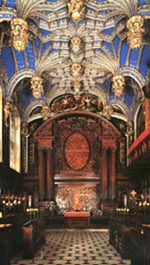 The Chapel Royal with its blue and gold ceiling.
The Chapel Royal with its blue and gold ceiling.
We peek into the Pages' Chamber nearby on our way to the awe-inspiring Chapel Royal where services are still held today, over 450 years after it was built. An organist plays while we wander the soaring chamber, admiring all the carved woodwork and staring up at the vaulted ceiling, painted blue with glittering gold stars. It is easy to imagine royalty worshiping here—Henry with one of his six wives, or Queen Anne, perhaps, sitting in the Royal Pew above.
By now it is long past time for lunch, so we wander out to the gardens and the tearoom in the old tiltyard. I usually love the English soups, but it's too hot for that today, so we grab some cool sandwiches and peach iced tea and push several tables together to seat our party of twelve. The sun beats in through the skylights overhead, so we don't linger long after eating.
Jane and Eddie's young sons have had enough of history for the day, so we book another afternoon tour without them. The boys are keen to try Hampton Court's maze before they leave, though, so we wander its hedge-lined paths, going right this time, which works quite well to lead us to the old trees in the maze's middle. Centuries of initials are carved into their trunks, but we have brought no tools to add our own. Bundles of energy despite the heat, the kids make it out long before the adults do.
We do a quick tour of the Tudor kitchens before bidding Jane and family goodbye. Then we head back to the Georgian House for a short rest before our 4:00 tour of William III's apartments. Jetlag is catching up with us, and the break seems entirely too short.
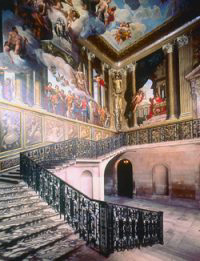 Staircase to King William's apartments.
Staircase to King William's apartments.
King William's apartments in the palace are massive and impressive,
beginning in the Guard Chamber which is decorated with more than three
thousand pistols and swords. Led by the same costumed gentleman who did
our welcome tour, we gawk at the glitzy chambers as we listen to him
describe a typical visit to Court. It is the last tour of the day. Clearly
sweltering in his silks, the guide explains how young bucks in the early
18th century adopted a negligent
style, then proceeds to
demonstrate, unbuttoning his waistcoat, loosening his long linen shirt,
untying his cravat and allowing it to dangle, um, negligently. The teen
girls find the look dashing indeed, although I doubt the poor guy is very
much cooler. Our little group is brimming with questions, and he
graciously stays after and answers them all, leading us on a personal tour
of the King's private rooms downstairs that guests usually wander through
themselves. Everyone here at the palace is very kind and helpful,
especially, it seems, after they find out we are residents.
By the time we are finished, the palace is closing to tourists, and the
kids are more than ready for dinner. Too hot and weary to want to drive
anywhere, we wander out of the palace and down to the street. Across the
road in the town of East Molesey, we search for somewhere to eat. We hope
to find someplace English
—a pub—but can't find any
serving food after 7:00 on a Sunday night. There are other
restaurants—Indian, Greek, Asian—but at each place, at least
one of the teens proclaims they will find nothing to eat. Wilting and
exhausted, we finally settle on pizza.
The restaurant is sweltering, and the kids miss huge American drinks with free refills. Our family rule is one coke and then water. But the pizza, at least, is okay.
We stop at a small market to stock up on water, coke, and bread, then walk back to Hampton Court to be greeted by the guard at the huge black and gold Trophy Gates. Despite the lingering heat and humidity, we smile as we stroll the long approach to our adopted home. With all the tourists gone for the day, the palace looms ahead, seemingly waiting for us.
The kids have discovered eight canvas lawn chairs in a small storage room in the back of the apartment. We drag them out to the garden and sit there reading for a while, enjoying the cooling air as the sun sets. When it's too dark to read, Jack and I head up to bed while the kids take flashlights and go out to explore the palace in the dark.
The master chamber is a haven, still humid but a bit cooler now with its
four windows thrown wide open to the night air. It's enormous, with a
double bed, a decadent chaise longue (or fainting couch
as Devon
likes to call them), a mirrored dressing table and chair, an antique
armoire and matching dresser, another chair with a seat that lifts to
reveal a opening for a chamber pot beneath, and a fireplace that we're
sure we won't be using in this weather.
For this week, it is home.
Monday, July 29
Since we're not meeting anyone today and don't have a scheduled tour, we sleep late and don't leave Hampton until 10:00. It's a short walk to the train station, just outside the palace gates and across a bridge, where we board a train for the thirty-five minute ride to London.
Our kids are old hands at this, but a train ride is a novelty for their
friends. As is the subway once we arrive, called the Underground or
tube
in London. The sticky weather still has not broken, and the
tube stations and trains are almost unbearably hot, but the kids enjoy the
rides anyway. Two lines and several stops later, we arrive at the Tower of
London.
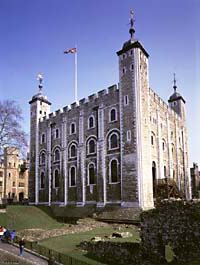 William the Conqueror's White Tower, the oldest part of the Tower of London.
William the Conqueror's White Tower, the oldest part of the Tower of London.
We've been here before, but our guests are awed at their first real glimpse of London: the remains of the old Roman wall, the gigantic moat, William the Conqueror's thousand-year-old White Tower, and all the buildings that have grown up around it over the centuries. Our Yeoman Warder tour guide has a terrific sense of humor and is much enjoyed by all. In the outer ward, we hear the story of the Monmouth Rebellion and the Duke's subsequent execution, including how they belatedly realized there was no portrait of the king's dead son, so they sewed his head back on and had him painted. By Traitor's Gate we hear the tragic tale of the two boy princes who were imprisoned in the Bloody Tower, then murdered by their uncle who eventually became King Richard III. In the ancient chapel, we walk over graves of beheaded prisoners, and there we hear the sad story of Anne Boleyn's death by a two-handed sword. After the tour we visit the Crown Jewels (a favorite of the girls) and all the armor in the White Tower (a favorite of the boys). Following lunch we do the wall walk and check out the medieval palace chambers, imagining ourselves as lords and ladies gazing out of the turrets and dancing beneath the gigantic round iron chandelier in the medieval Great Hall.
 View from the London Eye.
View from the London Eye.
We have five o'clock tickets to ride the London Eye, the biggest Ferris wheel in the world, so we have to leave the Tower of London partially unexplored. Since we're hot and our feet are killing us, this is not too disappointing.
The Underground is even hotter this time of day, crammed with commuters, and there is a long line for the Eye even for ticketholders. By the time we get to the front we are all wilted and crabby and happy to get into our air-conditioned capsule.
The ride takes us high above London, amazing views in all directions. We have bought a guidebook so we can recognize the landmarks. The wheel moves slowly, though, and it does get a bit boring after a while. Half an hour later we are glad to get out.
The Underground trains are emptier by now, and a bit cooler, and as we
ride the Northern Line toward Hampstead the kids have a pull-up
competition using the grip bars overhead. The girl gymnasts beat the older
boys handily. Once in Hampstead, it is a short hike to our favorite London
restaurant,
a little cart that has been selling crepes there for
over 20 years.
Such a hard decision. Ham and cheese, mushrooms and tarragon cream,
asparagus and garlic, all wrapped in crisp, paper-thin crepes practically
dripping with butter. We'll diet when we get home. There are no seats at
this restaurant,
nor do they sell drinks, so after making our
selections we carry them down the street to McDonalds, where we all order
large sodas and settle in air-conditioned splendor to devour our feast.
Then back to the cart for dessert, more crepes filled with chocolate and
nuts, or butter and sugar, or my particular favorite, crepes Suzette with
Grand Marnier. By the time we're finished, we're practically waddling back
to the tube station. But the crepes were worth every calorie.
We were thinking of doing a walking tour tonight, but we unanimously decide to head back to Hampton Court instead. We've done enough for one day.
Tuesday, July 30
Early train into London for a London Walks
walking tour, Behind Closed Doors.
Tom, our guide, is a tanned,
balding man with a friendly face and a quick, dry wit, and the kids take
to him immediately. This is a good thing, because once again it is
hot—even this early the air is still and thick enough to cut with a
knife—and I'd been afraid we might have a mutiny, kids refusing to
spend the day outside in this sticky heat. Watching the weather reports in
the days before we left, we'd been led to expect temperatures in the 60s,
so we haven't brought enough summer clothes. Every evening when we arrive
home there's been a race for the bathtubs—thankfully we have two,
but I never thought to see my kids so eager to keep clean.
We start at Covent Garden and walk to the stately Waldorf Hotel to see
their Palm Court ballroom, which was used as a model for the ballroom on
the Titanic—the real ship, not just the movie.
Much snapping of pictures here. Then off to the Royal College of Surgeons
and the museum there with an astonishing collection of early medical
curiosities, including the skeleton of a famous 18th century Irish
giant,
embryos in every stage of development, pickled brains
including that of the genius Charles Babbage, and diseased lungs. Everyone
is fascinated, but it's not long before we're off to somewhere else. A
17th century room in one of the few buildings that survived the Great Fire
of London, purportedly Prince Henry's office—Prince Henry being the
older brother of Charles the First, the man who would have been king had
he not died before their father. How would history have changed? Would
there have been a Civil War, a beheaded king, the Protectorate, the
Restoration? The mind boggles at the possibilities. The room is beautiful,
with original 17th century oak paneling, a detailed plasterwork ceiling
boasting Prince Henry's crest, and heraldic stained glass windows. It's
been transformed into a little museum honoring Samuel Pepys, the famous
diarist whose journals have given us so much insight into Charles II and
Restoration life. I'm in heaven, dragged out of there much too quickly,
but I do get a chance to buy a 17th century recipe book they have on sale.
More dishes to try, yay!
Then we're off to the Royal Courts of Justice, where Tom, a barrister although no longer practicing (for his sanity, he claims with a smile), explains all about how trials work in England, including who wears which sort of old-fashioned curly wigs and why the barristers' gowns have little pockets in the back (they used to be full-blown hoods). We sit down to watch a trial for a few minutes, something about prescription drugs and their labeling—we never do quite figure out what it was about, but we are surprised to see the judge and barrister joking in the middle of the trial. The courtroom is beautiful, old and ornate, the walls lined floor to ceiling with leather-bound books. Afterward, we peek into some other courtrooms and then go quickly 'round an exhibit chronicling the history of courtroom dress.
After the tour ends, Tom stays behind to talk to us and answers all our
silly questions. He's surprised to hear we're staying at Hampton
Court—it seems few people in England know it's even possible to stay
at Hampton Court. That was certainly the case at home in the
States—whenever we told anyone where we were going to stay, we'd get
a blank look and then, Is there a hotel named Hampton Court? You cannot
mean THE Hampton Court, after all.
Apparently it is as big a secret
here in the United Kingdom.
We finally leave Tom, probably much to his relief, and grab a quick pub lunch before heading off to the British Museum. We start, of course, with the Rosetta Stone, which the kids photograph from every angle as though hoping to capture its secrets. Darci wants to see all of the Egyptian stuff, Dan is interested in the Aztecs, and I want to see the artifacts from Medieval and Renaissance Europe. We play a little game in every room, five minutes to go around it each on our own, then we report back and show everyone our favorite item and state why. It's something we've done in museums since our kids were small, and their friends enjoy it very much.
 Dan, Blake, Brent, Jack, Devon, Anna, and Darci in front of the British
Museum.
Dan, Blake, Brent, Jack, Devon, Anna, and Darci in front of the British
Museum.
All too soon, the museum is closing, but that's not a bad thing since it's very hot inside, not to mention we've been on our feet all day and are feeling the painful effects. We take the tube to Piccadilly Circus and grab dinner before heading to the Criterion Theatre for a play entitled The Complete History of America—Abridged. Fourth row center seats, since I bought the tickets online early, and the theater (um, theatre) is gorgeous, three lavishly gilded levels with private boxes at the sides that look fit for royalty. We're surprised to enter and head down a staircase to the stage—the top balcony is street level and the rest underground! The play, acted by three clever American men with much improvisation, has us all in stitches for an hour and a half. We wish we had time to see their other production, The Complete Shakespeare—Abridged, which is the longest running show in London.
We make it back to Hampton Court at about 11:00, the first time we've come home in the dark. We walk through the gates to find the front of the palace all lit, glowing against the inky sky. It's an incredible sight, and the cameras come out for photos. We walk toward it slowly, almost reluctant to enter and leave the magical picture behind. Well, some of us do, anyway--Blake and Dan are racing slalom-style around the pillars that line the walk.
Boys will be boys, I suppose.
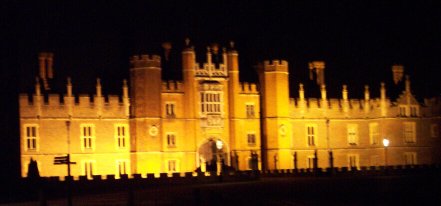 Hampton Court Palace lit up at night. Pictures don't really do it justice.
Hampton Court Palace lit up at night. Pictures don't really do it justice.
Wednesday, July 31
The weather has broken. We wake to rain, blessed rain, a pleasing staccato beat through our open windows. The palace walls are so thick that the wet hasn't reached inside—it would have to be blowing sideways to be a threat. And this isn't that sort of rain, it's a gentle rain, if steady. The Georgian House is cooler than it's been since we arrived, and we've all spent a restful night—except for Darci, who thought she saw a ghost in her room and spent the rest of the night awake. A woman, she says, visible in the mirror, pacing back and forth in front of the window. Not a threatening ghost, but she's unsettled all the same.
We get up at the crack of dawn to make the long drive to Salisbury, leaving at 7:00 to be sure to get there in time for an 11 o'clock walking tour. The rain continues most of the way, but is only a gentle drizzle when we arrive, an hour and a half early. We take breakfast in a café, then walk to the town information center to meet our guide. She's a tall, thin, no nonsense sort of woman who is obviously more conditioned to walking than any of us. We learn the history of Salisbury and the town two miles away that it evolved from, now called Old Sarum, that has been a settlement since the Iron Age. Her information is thorough and interesting, but delivered without the charm of our beloved Tom. By the time we reach the tour's end, at the imposing Salisbury Cathedral, we are a bit relieved to be left to explore it on our own.
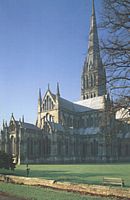 Salisbury Cathedral.
Salisbury Cathedral.
The cathedral is so grand as to be awe-inspiring, especially considering its foundation stones were laid in 1220. The tower and its octagonal spire, the tallest in England, were added a century later to a building that had not been designed to hold its weight, and we see inside where the walls have bowed as a result. We learn that buttressing was added as support, apparently successfully, since Christopher Wren measured the spire's tilt three hundred years ago and it hasn't moved at all since.
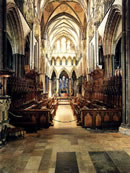 The interior of the Cathedral.
The interior of the Cathedral.
The cathedral houses many old tombs (fascinating for the kids) as well as the world's oldest working clock (built in 1386, it doesn't have a face—it only strikes the time). After exploring the cathedral, we walk through the lovely cloisters to the Chapter House to see one of the four remaining copies of the Magna Carta. It's in Latin, so we can't read it, but we all agree that such an ancient document is worth looking at anyway. The octagonal Chapter House is beautiful, the fan-vaulted ceiling opening out from a single pillar, the walls almost all stained-glass windows, so intricate they look like lace. Devon has recently read Ken Follett's Pillars of the Earth, one of my all-time favorite books about the building of a cathedral in the same period as Salisbury's, and we talk about how much more special it is to see the cathedral and chapter house after reading about such things. I hope my boys will read Pillars now, too, and be able to picture the cathedral and the turbulent history of the times.
 Brent and Darci at (a deceptively empty-looking) Stonehenge.
Brent and Darci at (a deceptively empty-looking) Stonehenge.
After a quick lunch—Pizza Hut, not at all my choice, but the kids insist since they are one of few restaurants in the UK that offer free drink refills—we drive to Old Sarum to explore the ruins of its castle and cathedral. Darci wants to be an archeologist, so she's entranced, but the other kids seem most interested in racing along the jagged cliffside walls in an effort to give me a heart attack (I suffer from a fear of heights that they all seem to find highly amusing). Following a quick game of Red Rover in the inner bailey, we pile back into the van to drive to Stonehenge. Our whole group finds the standing stones fascinating, photographing them from every angle, but none of the teens seem at all interested in listening to the recorded information (which was very thorough, although admittedly a bit slow and dry).
Jack becomes sleepy on the long way home, and since I can't drive our oversized, stick-shift vehicle on the left side of the road, we pull off the motorway at Basingstoke and into a parking lot to let him sleep for a while. The children and I go off to explore, but this is England, and it is past six o'clock, so all the shops are closed. We walk about half a mile and do manage to find an open supermarket, a good thing since we are running low on breakfast supplies. Tomorrow night is our anniversary, so I ask the kids if they'd mind being left alone at the palace at night so Jack and I might go out to dinner. Mind? They're thrilled at the prospect and gleefully choose groceries to cook themselves dinner. An hour later we make our way back to the van to find Jack rested and ready to roll.
By now we're starving, but there's nothing except pizza near Hampton Court, so we decide to drive on to Richmond. Big mistake. Richmond is a posh community that doesn't cater to middle-class families. Wednesday night after eight, none of the pubs will allow children. We walk up and down all the streets in the center of town, but other than pricey, fancy restaurants, the only place we can find open is—you guessed it!—a pizzaria. Luckily they serve pasta as well, because I can think of little less appealing than pizza for the second time this day. Brent and I share two excellent dishes, yummy gnocchi in pesto and bow-tie pasta in a creamy tomato sauce with chicken. Jack eats pasta with assorted shellfish. The rest of our party orders…pizza.
It is midnight by the time we arrive home, and although the palace is lit again this night, we are not tempted to linger and gaze. Our beds await.
Thursday, August 1
This has been designated a research morning, so Jack and I get up early and let the kids sleep in. My book Rose will be partially set at Hampton Court, and since Rose's hero is an architect working on an addition there, I need to find out, if at all possible, what he might be building. Most every king made changes to the palace, but most of what Charles II added has disappeared without a trace. I have read, however, that at one point he had apartments built—or renovated, it wasn't clear—for his mistress Barbara Palmer and their five illegitimate children. I'm hoping to find out exactly where those might have been.
We start at the information center, where a lovely woman named Michelle would very much like to help but hasn't a clue what I'm talking about. She does, however, have some phone numbers and manages to get hold of a warden named Ian Franklin, who apparently does know what I'm talking about and thinks the apartments were located on the raised area at the edge of the privy garden, by Henry VIII's Water Gallery, which sadly is long gone. We hurry to find Ian, near the back gate of the palace, and he elaborates before we go off to the privy garden to locate where the building would have been and snap some pictures of the area. Ian suggests I find a copy of Ernest Law's out-of-print threebook series on Hampton Court history, but warns it will cost at least 200 pounds (about $320 American)—which I already know, because I've been searching for a copy online. Ian's been looking for a copy, too. He gives me his screen name and asks me kindly not to bid against him in any online auctions. He also suggests I may want to contact the official palace curator and gives me the man's name and number. All in all, a quest that I'd feared might be hopeless has turned out to be rather simple, and I am more than pleased.
 The privy garden, looking toward the palace. Barbara Palmer's apartments
would have been on the raised area to the right.
The privy garden, looking toward the palace. Barbara Palmer's apartments
would have been on the raised area to the right.
We had rushed through the privy garden earlier this week, but now we take our time, walking the paths, admiring all the flowers, and visiting William III's Banqueting House. It's lovely, but it replaced Henry VIII's Water Gallery, and I wish I could see that instead. I try to imagine Barbara Palmer living there, standing on the balcony Charles II built for her over the Thames, and later in the new apartments he had constructed. A warden tells us Henry had his own banqueting house, too, decorated with gold and gemstones. I shall have to do my best to find some old drawings or paintings, since none of this still exists.
We go to see the Great Vine, the oldest grape vine in England, and into
the Orangery to see Andrea Mantegna's Triumphs of Caesar,
a series
of nine huge paintings from the 15th century, bought by Charles I and
brought to Hampton Court in 1630.
Back in the palace, we have a loooong conversation with Ian, who likes to talk and knows so much about Hampton Court that I could probably listen for a week. It turns out that although he is not an official curator, he is an acknowledged expert who has done several television specials on Hampton Court's ghosts. And since he is considered Hampton's official ghost historian, he is very interested in hearing about Darci's ghost. He hasn't heard of any ghosts in the Georgian House as yet, so he's disappointed that he's off the next few days and won't be able to interview her. He asks us to have Darci write up an account of what she's seen and leave it at the wardens' office for him to pick up on his return, explaining that he collects these stories and waits to see if he gets several similar ones before deciding if the ghost might be real.
We have plans today, so we reluctantly leave Ian at about noon and return to the Georgian House to wake the kids. Darci is thrilled to hear that an expert is interested in her ghost story and starts writing it immediately. While the kids get ready and wolf down some breakfast, we visit the old Royal Tennis Court, built by Charles I, where I watch people play the odd indoor game of Royal tennis and try vainly to figure out the rules. There are some signs explaining how it works, and I take pictures of them to study later, but since I plan to have a tennis scene in Rose I suspect I will have to find a book or more information on the internet.
The boys decide they're still exhausted and want to stay home, so we set off for Hatfield House with Devon, Anna, and Darci.
 Hatfield House with Lauren, Devon, Anna, and Darci standing by (or on,
in Devon's case) the gatepost.
Hatfield House with Lauren, Devon, Anna, and Darci standing by (or on,
in Devon's case) the gatepost.
Hatfield House was the first Queen Elizabeth's childhood home, and also Trick Caldwell's house in Amber. I found it on a research trip with my mom, and no one else in my family has seen it. Devon is a QEI buff, so she's been begging to go there our last two trips, but I've always had other research to do. After an hour's drive, seeing it again is like coming home. We take the guided tour of the magnificent main house (pictures on my Real Places page), which was actually built after Elizabeth's time, then walk to what is left of the old palace where she lived and the even older church nearby. There are many ancient tombs inside, including an unusual one of a mother and daughter with their effigies lying on their sides. The church resonates history; Samuel Pepys worshiped here once, as did Charles I shortly before his execution.
The afternoon seems very calm and quiet without the three boys.
Jack and I drive to Windsor that night to celfbrate our anniversary at our favorite UK restaurant, Brown's—not a very fancy place, but a comfortable one with great food. We've eaten at Brown's in London, but never this one before. There's a half hour wait, so we put our name on the list and take a walk along the Thames. Windsor is another setting for Rose, and although I've been there three times already and researched thoroughly, there is always more to learn. Two scenes pop into my head as we stroll the banks, so I pull out my ever-present notebook and make notes and take photos. We go behind Christopher Wren's house and take pictures there, too—another place that I'm using in Rose. I've toured the house twice and even stayed there overnight (it's run as a hotel now), but I never realized I could access the back from the riverside.
Dinner is lovely: salad and portabello mushroom ravioli for starters, then we share grilled lamb and one of Brown's famous steak and ale pies in puff pastry. Creme brulee is not necessary after all of that, but it's too delicious to pass up.
After dinner we walk the other direction along the Thames and over the Eton bridge. I make more notes and take more pictures although it is really too dark.
What a wonderful, productive day. I hope the six kids haven't damaged the Georgian House while we were gone.
Friday, August 2
The teens went to bed last night before we got back, without cleaning the
dining room or kitchen following their self-made feast. Big surprise. We
get them up early to set the house to rights, relieved to see no permanent
damage. Then we're off to London for another London Walks tour called
Fit For A King,
this one an all-day affair starting at ten o'clock.
It's been a long week, and everyone's rather dazed on the train ride, but when we get on the tube and spot Tom the Good Guide, the kids perk up. (London Walks has about twenty guides, so it's amazing that we should get him again!) Though these groups generally run to twenty or thirty people, the turnout for this tour is small—the eight of us, three single women from Australia, Sweden, and England, and two women from New York City, one of them extremely annoying. I have nothing against NYC—my mother was born there, I have family there still, and I think it's a grand place overall—but this is the sort of person that gives New Yorkers a bad name.
The weather is perfect today, and the tour starts at Wellington Arch. We take an elevator to the top and are able to peek into the gardens of Buckingham Palace, where no one is playing on their tennis courts (regular outdoor ones, not Royal ones, no matter that they're royalty!). Suddenly we see the Horse Guards emerge from Hyde Park across the street, riding straight toward us. Dressed in crimson, black, and gold, the guards ride under the arch, and we all rush to the other side to see them emerge. Then we watch them ride down the Mall, a mechanical pooper scooper driving behind. Miss NY loudly proclaims that this is disgusting.
When it's time to leave, we find out the elevator has broken, and I am not good on steep, winding stairs—that fear of heights. Jack walks down in front of me so I can't see down, going very slowly to match my snail's pace. I am proud of myself when I make it to the bottom without whining, and only a little bit shaky.
Off we go to Buckingham Palace, a place I've never seen despite many visits to London. Unfortunately, our timing couldn't be worse. Starting yesterday, the Changing of the Guard went to a winter schedule, odd days only, and today is an even day. And the palace's annual opening starts August 5th—this is the 2nd. But Tom tells us many amusing stories as we stand outside (laughing at the hundreds of people who have gathered to wait for the Changing of the Guard that won't be happening).
 Blake, Dan, Anna, St. James's Palace guard, Brent, Devon, and Darci.
Note that nobody in our party is touching the guard.
Blake, Dan, Anna, St. James's Palace guard, Brent, Devon, and Darci.
Note that nobody in our party is touching the guard.
We see the Horse Guards again, now at their Guard House posts by the gates where the old guardhouse for the 16th century palace of Whitehall once stood. The guards are young—seventeen or thereabouts—and look quite natty in their scarlet uniforms with shining metal helmets and breastplates and knee-high polished black boots. Our teen girls giggle and take pictures. Next we're off to St. James's Palace, the only place where one can stand next to the palace guards with their huge black furry hats. More giggling and pictures. The guards don't talk, but from time to time they quite suddenly shift their rifles, startling the girls posing beside them.
Miss NY puts her arm around a guard even though Tom has told us that we are not to walk behind them or touch them.
We hear the history of St. James's Palace and learn that Prince Charles
lives here now. Miss NY calls him a womanizing pig.
Tom points out
that Camilla is only one woman, but Miss NY is not interested in
listening. Tom explains that since this is a Royal residence we cannot go
inside, at which point Miss NY marches over to an open door and walks in.
Tom shakes his head and leads the rest of us away, but unfortunately she
catches up.
We walk past Ten Downing Street complete with a loud demonstration outside—something about the rights of Kurdish women. Miss NY heartily approves although it is clear she has no understanding of the politics involved.
Finally we reach the Banqueting House, the only remaining building of the old Whitehall Palace, the rest of which burned in 1698. Here we go inside.
Built by Inigo Jones for King James I in a classical Palladian style, the
Banqueting House was the first modern
building in London. The
magnificent ceiling was painted by Sir Peter Paul Rubens and commissioned
by Charles I, who was unaware at the time that the Banqueting House would
be the scene of his own beheading. Tom describes that fateful day in such
detail that we can almost see it. What is it,
Miss NY caustically
asks, with your country and all the beheadings?
So much for the
atmospheric imaginings.
It is time for our lunch break, anyway.
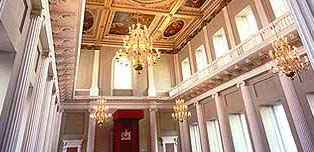 The interior of the Banqueting House, with Rubens's ceiling and the
balconies all around.
The interior of the Banqueting House, with Rubens's ceiling and the
balconies all around.
But we stick around for a few minutes after the others have left, because I've planned a scene in Rose to take place here, too. I imagine that as well, lords and ladies dancing on the parquet floor, lit by hundreds of candles in the chandeliers, while more courtiers watch from the balconies all around. Out comes the notebook, and I take a few pictures before we leave.
We've been allotted an hour for lunch, and of all the places Tom has
described, the Café in the Crypt (in St. Martin-in-the-Fields
Church) sounds the most interesting. It is also, of course, the farthest,
and we rush, hoping to have time left over to see the church, too. But
when we get there, two of the kids cannot find anything to eat.
There is no pizza.
We hurry back toward the Banqueting House where the tour will resume, stopping at a pub along the way. They promise to deliver food in 15 minutes but take 30. We have five minutes to eat and end up running to catch the tour, but of course Tom hasn't left without us. We're more than half the group, and besides, he would miss us, we're sure!
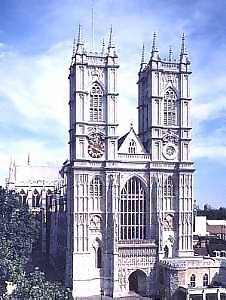 The front of Westminster Abbey.
The front of Westminster Abbey.
Now we're off to Westminster Abbey, consecrated in 1065, and the setting for every coronation since 1066—surely one of the most impressive places in all of England. The building soars above us, stone and glass that has stood for ages.
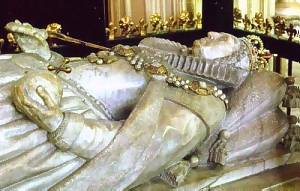 Queen Elizabeth I's memorial—sorry you can't see her face better,
but we didn't climb on it!
Queen Elizabeth I's memorial—sorry you can't see her face better,
but we didn't climb on it!
Tom takes us to see the Tomb of the Unknown Warrior, one of over three thousand people buried or memorialized here. We visit the burial places of kings, scientists, statesmen, musicians, writers, and poets. Sir Isaac Newton, Charles Darwin, Geoffrey Chaucer, Charles Dickens, George Frederic Handel, Laurence Olivier. Miss NY climbs on the memorial over Queen Elizabeth's grave in order to get a better look at her carved stone face.
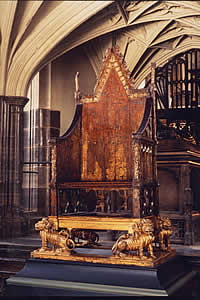 The Coronation Chair
The Coronation Chair
We see the Coronation Chair, and Tom tells stories of mishaps during various coronations. There is a marker where Oliver Cromwell was once buried, and we hear the tale of how his corpse was later dug up, hung, and decapitated.
Miss NY stays strangely silent. I don't think she knows who Oliver Cromwell was.
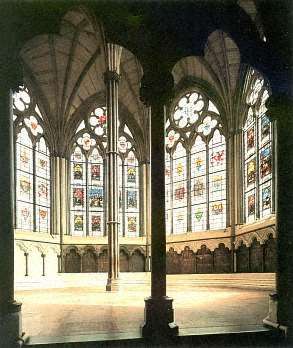 The Chapter House.
The Chapter House.
A quick tour of the Chapter House, not quite as pretty as Salisbury Cathedral's, but we love the original medieval tile floor. All too soon, it is time to bid Tom farewell. We are not nearly as sad to leave Miss NY.
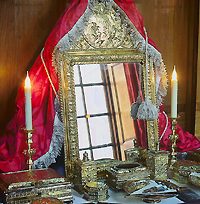 Queen Caroline's dressing table.
Queen Caroline's dressing table.
On the way to the Underground, we stop to take pictures in front of Big Ben. After a week of walking, our feet thank us when we settle on the train for our last ride back to Hampton Court. We are met at the station by our friends Andrew and Libby, and we hurry toward the palace, the kids anxious to hit the gift shop for one last time before it closes. After making their final purchases, we practically run through the chambers we have yet to see: the Queen's State Apartments—spectacular rooms with magnificent views over the gardens and parks—and the Georgian Rooms, George II and Queen Caroline's private chambers. We love Caroline's soaring gold tester bed and her bathroom with its marble cistern and wooden tub lined with linen. Pausing for a moment, I can picture her seated at her dressing table using the silver-gilt brush, comb, and atomizer that match the mirror.
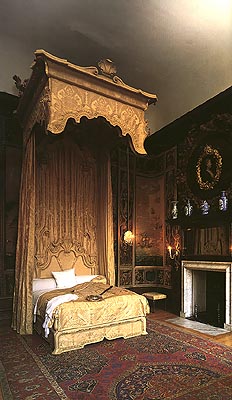 Queen Caroline's bed.
Queen Caroline's bed.
By the time the palace closes, everyone is starving. Since we don't want pizza and that's all that's available nearby, we squeeze all ten of us into the van and drive to Kingston-upon-Thames for dinner. Andrew and Libby sit in front with Jack; it's a relief to let someone else navigate for a change. Although I'd prefer something English our last night, the kids vote for TGI Friday's since they have free drink refills. I don't really care what I eat since the company is so nice; our kids have always liked Andrew and Libby, and since Andrew is a fan of computer games, he and the boys become instant friends. The rest of us shrug and pretend to understand the conversation.
Libby suggests a walk along the Thames, but the kids groan, so we drive
them back to the palace and instruct them to start packing while we adults
walk by the river there instead. It's a lovely night, cool but not cold,
laughter drifting across the Thames from the inns on the other side. When
the sun sets, we return to the Georgian House for flashlights and to
remind the kids to pack, then walk through Hampton Court's gardens one
more time. Our flashlights dance over the trees and flowers, the fountain
in the middle of the grand semi-circular garden planned by Charles II, the
moonlight glinting off the Long Water
—his manmade canal fed
by the Longford River. Though his lime trees are long gone, his basic
layout still remains.
Then we bid Andrew and Libby goodbye. The children, of course, have not packed, but I hand them flashlights and ask them to come along on one more walk of the palace itself.
What would it be like, I ask, to walk here at night in 1677? I have a scene in mind, one that takes place in the dead of the night. What do you hear, see, and smell? The impressions come fast and furious and, notebook in hand, I scribble them all down while they take turns focusing their flashlights on my pages.
Flickering light from the torches that would be on the walls where we see lamps now. Chilly breezes in a hallway. The scent of damp stone, the splash of a fountain. Light dancing off diamond-paned windows, the smell of cut grass, chimneys silhouetted against the sky. Uneven cobblestones in the courtyards and smoother tiles in the arcades. Cool brick walls, colder stone, and even colder glass. Murmuring voices from the Great Hall and the private apartments where courtiers would have lodged.
We see a shooting star, and I promise I will put it into the story.
When Jack and I hit our pillows at midnight, the kids still haven't packed. They've decided to stay up all night, to savor their last hours in England. They can sleep on the plane, they say, and we hear their low voices coming from our garden as we drift off to sleep.
Saturday, August 3
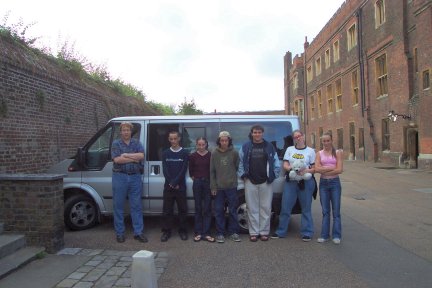 Jack, Dan, Devon, Blake, Brent, Darci, and Anna standing in Tennis Court
in front of
Jack, Dan, Devon, Blake, Brent, Darci, and Anna standing in Tennis Court
in front of The Box,our gigantic van, as we're about to leave.
In the morning, Jack has to wake the kids, who have all fallen asleep in
the sitting room. Just a few minutes ago,
they claim. But
miraculously, everyone is packed. Darci has finished writing her ghost
story for Ian. Not to be outdone, Blake claims to have heard ghostly
footsteps in the garden, and he writes his account in the guest book. Anna
has drawn a beautiful image of the Hampton Court crest, and everyone else
has written messages. I add my own, then we haul everything into the van
and head for Gatwick Airport.
 Mmm…doesn't this make you want to rush out and fly on Northwest?
Mmm…doesn't this make you want to rush out and fly on Northwest?
The first flight is long but uneventful except for a meal that is so
unappetizing there is nothing we can do but laugh (eating it is out of the
question). If you want a description of the food
(I use that term
loosely), check out AirlineMeals.net.
(Once you get to the site, click on Northwest Airlines and look for entry
number 06 by the Royal family.)
Now we are on the final leg of our odyssey, one last flight from Minneapolis back to Los Angeles. We've had a wonderful time, but everyone is ready to go home. We miss cats and dogs and girlfriends. Some of us may even miss parents. And we all miss our beds.
The kids are all sleeping now as I type this. Maybe they did stay up all night. I hope they're having sweet dreams…I know I have wonderful memories.









